
Article reposted from My Wabash Valley.com
Author: Rebecca Brumfield

Article reposted from My Wabash Valley.com
Author: Rebecca Brumfield
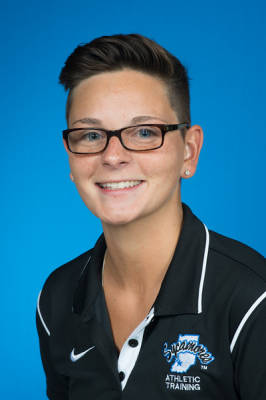
Article reposted from newswise
Author: Indiana State University
One could say it was a bit of a culture shock for Emma Nye when she moved from her home state of New York to Indiana in pursuit of a master’s degree in athletic training at Indiana State University.
Not long after her arrival in 2014, Nye, who is a student in the Doctor of Athletic Training program, was greeted by the state legislature’s passage of the Religious Freedom Restoration Act. Opponents of the law said it could be used to discriminate against individuals who identified as LGBT.
“I couldn’t really wrap my head around that type of discrimination,” said Nye, who is gay. “I went to the Capitol building in Indianapolis and protested, and I felt like my passion for advocacy turned into tangible action.”
Nye returned to campus determined to make Indiana State more inclusive of people from all genders, races, religions and sexual orientations. She approached the university’s diversity committee about boosting the campus’ Campus Pride Index, an LGBT national benchmarking tool for colleges and university to create safer, more inclusive campus communities.
“Indiana State is a 3.5 out of 5, so there is room for growth there,” Nye said. “We brainstormed ways to make the athletics department and athletic training department more inclusive for our athletes, our fans, and I’m excited about the research I’m conducting to see what the problem is and then how to fix it.”
Starting last summer, Nye and fellow doctorate of athletic training students Ashley Crossway and Sean Rogers began researching the perceptions of student-athletes who work with an athletic trainer who identifies as LGBT and perceptions of athletic trainers who work with student-athletes who identify as LGBT.
They are in the process of doing a pilot study with a survey tool consisting of question on care and quality of care as it relates to things such as gender, religion and sexual orientation. The survey will be sent out this spring to all NCAA Division I, II and III athletic trainers and student-athletes.
“We really want to know if someone is working with an athletic trainer who identifies with the LGBTQ community, does that change the way you collaborate? Or if you, as an athletic trainer, are working with a student-athlete who identifies as LGBT does that change your quality of care or approach to athletic training, in general?” Nye said. “We’re hoping not to find a difference, but if we do, then we’ve figured out the problem and can move forward to find a solution because this an environment where people can come, no matter their sexual orientation, gender identity, race or religion, and you will get high quality patient care. We want to bridge a gap if there is one, and I think it will boil down to education.”
It’s not her first go-around with this topic. Two years ago, Nye wrote an article for the Journal of Contemporary Athletics about workplace discrimination and the importance of passing the Equality Act, an anti-discriminatory workplace act.
“The article focused on key things that not only organizations but also individuals can do to make the athletic training room more inclusive,” she said. “What it came down to was the importance of advocacy and having a voice in the community. Oftentimes we get frustrated with potential negative legislation, but we don’t take action. It’s about speaking up and giving a voice to those in the LGBT community who feel stuck and don’t know what to do.”
Nye, ’17, has a graduate assistantship with athletic training program, where she has received hands-on training as an athletic trainer for Sycamore volleyball and Terre Haute South High School and serves as a preceptor for the athletic training education program.
Her efforts also won her recognition as the 2016 recipient of the Indiana Athletic Trainers Association’s Diversity Award.
“I was impressed that the award went to a member of the LGBT community because sometimes when people think of diversity, they think of race and ethnicity, and there are so many types of diversity represented by the people in the athletic training membership. I was happy to be able to represent the LGBT athletic trainers,” Nye said.
Nye’s work inspired her nominator, Zachary Winkelmann, a Ph.D. student in the curriculum and instruction program who teaches in the athletic training program.
“Emma continues to break down cultural barriers in health care, including patient perceptions of working with a health care provider who is LGBTQ and explore new avenues to share her message through dissemination of peer-reviewed publications and continued cultural competence of differing populations,” said Winkelmann, who accepted the award in October on behalf of Nye, who was traveling with the volleyball team in Iowa.
It’s a profession Nye found her way to after not having access to an athletic trainer during high school.
“I would often treat myself and figure out how to deal with injuries I sustained,” she said. “Once I realized what an athletic trainer was and how helpful they are for the performance of an athlete, I knew I wanted to pursue a degree in athletic training.”
The two main outcomes of Indiana State’s program, education and advocacy, are perfectly aligned with Nye’s two biggest passions.
“It’s almost like the program helped me develop my passion to educate others and to advocate for certain populations, and I feel like I’ve made a difference in Indiana,” she said. “I’m glad I pursued this avenue, because the program’s not just about athletic training skills, but about being a better overall athletic trainer.”
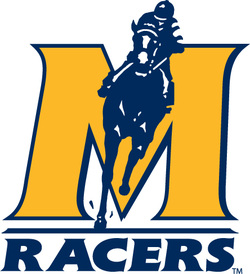
Article reposted from The News.org
Author: ABBY SIEGEL
The bachelor’s degree currently offered in athletic training at Murray State will soon be phased out, with the last group of students graduating in May of 2018, program director Kristan Erdmann said.
However, a Master of Science in Athletic Training will be offered at Murray State beginning in the summer 2017.
Jeremy Erdmann, admission coordinator for the program, said the athletic training program has been accredited since 2005. However, he said the national organization decided to shift the level of professional education, which will officially begin in 2021.
“Murray State wanted to get ahead of the ball game and develop that program earlier so our students are graduating with a master’s degree instead of a bachelor’s degree,” Erdmann said.
He said anyone with the prerequisites can apply to the program. There are two routes available to students: traditional and accelerated.
He said the traditional route allows the student to achieve their bachelor’s degree and then apply to the master’s program, which will last two years.
He said the accelerated route is unique to the region because it allows students to major in exercise science and complete three years of the degree and then begin the first year of the master’s program during the last year of the bachelor’s program.
Kristan Erdmann said this is the only “three plus two” program available at Murray State, with an immersive clinical curriculum.
She said the master’s program allows the student to get a full experiential education combined with didactic learning and she said there is a portion of the accelerated learning courses that allows the student to work alongside other athletic trainers in the field locally.
Isabella Meeks, junior from Princeton, Kentucky, said she has always wanted to go into athletic training and believes that Murray State has one of the best programs around.
“It is probably the shortest but most efficient way to become an athletic trainer,” Meeks said.
She said she is excited to work with the sports teams through the master’s program.
Cody Molls, freshman from Fredonia, Kentucky, said, “I want to help people and this is the best way I see to do that. I am excited to be able to work hands-on.”
There will be a deadline to apply to the program, but the date is unofficial. The next information session is at 5 p.m. on Oct. 19 in 409 Oakley Applied Science Building.

Article reposted from kstatesports
Author: Corbin McGuire
“I really felt like I was prepared in the classroom. I studied what I needed to know in there, but then I also got an education on things you can’t learn in the books,” she said of working with K-State Athletics. “I didn’t see how important that was at the time, but looking back, I think it was an advantage, and I’m really appreciative that they were able to get me through to that next step.”
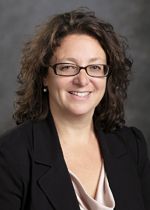
Article reposted from Misericordia University
Author: Misericordia University
The eighth annual conference is being hosted by the University of Oxford and Oxford Brookes University. Conference events are a platform where practitioners, service users, teachers, managers, policymakers and researchers compare perspectives, exchanges experiences, and pool resources in response to needs everywhere to effect change, enhance quality, and improve safety in care, according to All Together Better Health.
Dr. Kahanov is making the presentations entitled, “Leveraging a Campus Clinic to Expand Interprofessional Education and Research,” and “Interprofessional Education through Mobile Outreach Clinics.”
In her first presentation, Dr. Kahanov explains how interprofessional care has become a required component among many health care education programs. She also acknowledges that national organizations have likewise identified the importance of interprofessional teams in the delivery of quality, safe health care. Due to limited fieldwork opportunities, educational institutions, such as Misericordia University, have had to create their own interprofessional clinical experiences for students by establishing on-campus clinics.
The “Interprofessional Education through Mobile Outreach Clinics” presentation outlines the importance of creating an interprofessional environment for clinical experiences, and how to accomplish it through the formation of several mobile outreach clinics. Misericordia University, for example, created small, mobile interprofessional clinical experiences that centered on addressing the health care needs in the aging and autistic communities. The hands-on learning opportunities include a falls prevention clinic, autism sensory camp, autism workforce program, migrant worker clinic, Parkinson and stroke treatment program, and a chronic pain program located at regional nursing homes, community centers and schools.
More than 120 Misericordia University students participate annually in these clinical rotations, and provide more than $750,000 in free clinical services. In the near future, Misericordia plans add financial counseling, art, and patient navigation to the patient-centered mobile clinics in order to enhance a broader understanding of interprofessional care, according to Dr. Kahanov.
Dr. Kahanov is a certified athletic trainer with a doctorate in education from the University of San Francisco, San Francisco, Calif. She earned a master’s degree in exercise and sports sciences from the University of Arizona, Tucson, Ariz., and a Bachelor of Science degree in exercise science and athletic training from Indiana University, Bloomington, Ind.
The Misericordia University College of Health Sciences and Education offers bachelor, master and clinical doctorate degree programs, as well as certificate programs in specialized areas. The areas include the departments of education, nursing, occupational therapy, physical therapy, medical imaging, speech-language pathology, health informatics, medical imaging and diagnostic medical sonography, as well as the Assistive Technology Research Institute.
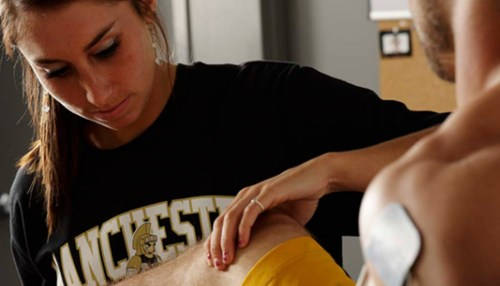
Article reposted from The Journal Gazette
Author: The Journal Gazette
Manchester University said today it would begin a five-year dual program leading to a bachelor’s degree in exercise science and fitness and a master of athletic training degree.
The program will enable students to complete two degrees in five years that would normally take six, the North Manchester-based university said in a statement.
Beginning in 2022, anyone who wants to become a certified athletic trainer first must have a master’s degree from an accredited athletic training education program such as Manchester’s, the statement said.
It said students will complete requirements for the bachelor’s degree on an accelerated three-year schedule, taking courses in the summer, fall, January and spring sessions each year.
They will apply to the master’s program after the second year, and begin graduate studies in the summer after the third year, the statement said. After completing degree requirements, they are eligible to take the examination leading to the Certified Athletic Trainer credential.
Manchester said it would not accept students to its current undergraduate major in athletic training after the fall 2016 semester “in order to protect the investment and future marketability of its students.”
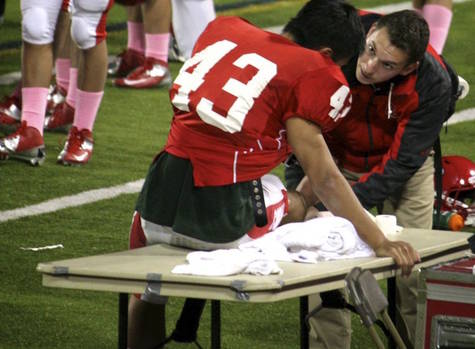
Article reposted from iPetitions
Author: Paul Geisler
CLICK HERE TO READ AND/OR SIGN THE PETITION
Date: July 19, 2016
To: NATA Board of Directors, NATA Executive Committee for Education, NATA Education Advancement Committee, and NATA Professional Education Committee
Re: Grave Concerns for the future of the Athletic Training Profession
From: Concerned Athletic Training Professionals
————————————————————————————————————
Given the current events and conversations regarding the transition to the master’s degree and the newly proposed CAATE Standards and educational content, we the undersigned wish to take this opportunity to express our collective concerns and apprehension for the future of our educational organization, programs and larger profession.
Specifically, we wish to bring to your attention that we are troubled by some of the recent practices employed and working documents intended to direct and structure our impending transformation to the professional master’s degree in Athletic Training and the future of our profession.
SYNOPSIS of KEY POINTS:
1. It is our opinion that many of the newly proposed standards for educational content far exceed most, if not all state practice act guidelines and specifications, and if approved establishes a dramatically new professional scope of practice and body of knowledge for athletic training, without compelling evidence or rationale to do so and without full consideration of the many legislative, professional and interprofessional domino effects likely to occur as a result.
2. Many of the newly proposed skills and knowledge standards clearly “belong” to other healthcare practices (mostly medicine), and bring with them drastic increases in both responsibility and liability for athletic trainers. If accepted/implemented, they indicate a clear and aggressive expansion of our “claimed” body of knowledge and professional practice, all without the disciplinary or professional legacy for doing so.
3. Some of the mechanisms and positions projected by the CAATE have been poorly communicated and authenticated to the larger professional body, especially as it has regarded seeking, implementing and reporting relevant evidence or professional consensus and insight from interested and vested parties (on a large and representative scale). It is not “change” and progress that concerns us, but rather we are deeply concerned with “how” future change has and is being implemented by a very small minority of professionals working on behalf of us all, the larger profession.
********************************************
Detailed Issues of Concern:
A. Directionally, we are at a minimum concerned with the following issues, proposals or intentions inherent within the 2 CAATE standards documents (SD1 =Operational, SD2 = Curricular Content) currently open for review and commentary by the professional body:
1. Significantly expanded Clinical Education Standards (#22, 23, 24 in SD1) that not only significantly stretch program resources and potentialities, but also greatly expand our professional domains and practice. Requiring AT programs to provide clinical experiences for all students in occupational, leisure, military, industrial settings (23), and to provide “sufficient experiences” in a truly authentic medical rotation/location (24) further implies a stretching of our domain of practice and expertise and infringes upon other health care professionals and their well established scopes and professional bodies of knowledge, and target patients. In order for those myriad experiences to be of authentic value and meaning for our students, the educational components required to prepare students for more intense general medical and occupational medicine (for example) are significant and for the most part prohibitive, given the existing depth and breadth of the requirements. As an aside, the central job of entry-level education is to create competent clinicians that can quickly progress to greater levels of expertise and acquire job specific skills and knowledge germane to the setting and expectations; and to prepare them for “post professional” or “advanced” education in chosen domains of practice. These new standards go well beyond our basic and traditional scope of practice and place significant and undue burdens on educational programs and educators. Competent clinicians are competence clinicians—they are capable of performing the skills sets and have the knowledge to effectively carry out the domains of practice in which they are trained (i.e., low back pain in an athlete requires the same base and applied skill set to manage low back pain in a military athlete or industrial patient, only with a different context and the application of sound clinical reasoning); on the job training is different than entry-level training and competent clinicians can adapt and transform their skills and knowledge for various populations upon graduation. In short, the entry-level education system cannot possibly educate all students for all possible jobs, all possible skills sets, or an ever increasing and expansive body of medical knowledge. Ironically, the NATA continues to support specialty certifications and the CAATE continues to accredit specialized residencies, indicating a clear need, time and place for more specific and advanced skill sets for athletic trainers interested in, or needing such skills for their vocational settings and aspirations.
2. Standard 35 (in SD2) calls for competence and decision making skills with “…blood work, urinalysis, and EKG/ECG” diagnostics. The amount of time and practice it takes to become “competent” in these skills far surpasses the structure and scope of entry-level athletic training. Further, it is yet another example of propositionally expanding far beyond our professional borders and into territories of other, established and legally entitled professions with FAR more education than ATs. In short, many of these are skills and knowledge central to medical practice writ large; and medicine, nursing and PA are sure (and right) to have serious concerns and complaints with this proposed expansion of scope of practice at both state and federal levels. At a time in which we are also asking for our healthcare colleagues to work with us on IPE and IPP initiatives and training, we find it problematic that on one hand we want to cooperate with them, and on the other we want to “do what they do”.
3. In our opinions, proposing that we teach future ATs to “ID and select appropriate pharmacological agents…” (39) and to “give medications…” (40) (both in SD2) effectively equates the prescribing and administration of OTC and/or prescription medicines, or in other words,practicing medicine. The medical, pharmacology, nursing (NP) and physician assistant (PA) associations and professions and state legislative bodies will be extremely (if they already are not) disturbed to see that we are intending to venture into these practice domains (not to mention the FDA, or the DEA). Not only will these standards open up the existing 48 AT state practice acts with contentious challenges and opposition from other professional and legislative bodies, costing hundreds of thousands of dollars per state, but it will also put the entire AT educational process and mechanism under intense pressure and scrutiny by our healthcare colleagues and elected officials (and with good reason). Further, even if it were professionally appropriate for ATs to be choosing and administering prescription medications, there is a practico-educational component that bears attention, as well—AT programs don’t have the time or space to adequately and competently educate “entry-level athletic training students” in the knowledge required to be proficient in these 2 Pharm standards, as this would clearly require AT LEAST 8-12 credit hours of chemistry pre-requisite coursework (Gen Chem, BIOChem, OrgChem), and likely another 8-12 credit hours of actual pharmacology knowledge and practice in the professional phase.
4. Standard 41 (SG2) calls for the inclusion of cardiovascular pharmacology skills, joint reductions, and suturing to be added to our educational package. This too would create additional professional domains of practice for AT that far exceed current practice, and if required, these would demand extensive knowledge and training that most AT programs would find very difficult to implement or do well. Knowing and using drugs for the myriad cardiac conditions is indeed a dangerous and high-risk arena to be in without adequate training and expertise. Performing reductions without pre/post imaging is dangerous and problematic with many joints (elbow, hip, ankle, knee), and suturing without pain reducing medication (injections) is inhumane, introduces serious risk of infection and tissue damage and can be accompanied by serious cosmetic issues in aesthetically pertinent areas and contexts. All of these proposed new skills are clearly outside the current scope of practice for most Entry-level athletic training contexts (except for those ATs working under the supervision of an MD who has taught and authorized them to perform, and if they are in a state whose practice act allows such practice) and are clearly strong and legitimate points of conflict for many state practice acts. Further, they place at risk our established but tender “interprofessional relations” with PT, medicine, PA and nursing (at least). At the risk of repetition, skills like these that happen legally and under MD supervision are further examples of advanced or specialty training, and in our opinion do not belong under the banner of entry-level athletic training.
5. Together, the proposed “content” standards in SD2 (and highlighted above) represent a fairly radical expansion of skills, knowledge and practice for athletic training—both educationally and professionally. We are not opposed to logical and strategic growth for the profession and are not advocating for stagnation, but this expansion of our professional “body of knowledge” into other professional domains, across many boundaries and well beyond our legal, established and historical scope represents to us a shortsighted and dangerous attempt to expand our profession, to become “something else”, something that we are not. At best, these proposals are clearly blurring the lines between “entry-level practice” and “advanced practice”, calling for ALL future athletic trainers to become competent with ALL possible job settings, tasks and domains of practice (a futile effort). At worst, they are calling for a completely new scope of professional practice, one that dangerously embarks into much deeper and more expanded exercises associated with the larger practice of “medicine”. In fact, it can even be said that these collective proposals (both documents) are passive calls for athletic trainers to completely remove their selves from the “under the supervision of a physician” clause that constitutes and undergirds at least 48 different state practice acts (thus becoming an NATA Code of Ethics issue?). For representatives of the CAATE and its various subcommittees to ignore or dismiss legislative concerns over our current and future practice acts, and how or if they will be impacted is in our view, short sighted, naïve and disrespectful to our health care colleagues, our legislative bodies and our public with which we have a social contract. Not only do we question the proposed and vast expansion of domain strategy in the name of “why not”, but the practical and legal aspects are equally troubling, as well. If approved and put into motion, all 48 state practice acts will be open for considerable scrutiny and debate, which can very likely turn into an extremely costly and vulnerable risk for our profession. It is conceivable that in the end, this multipronged border crossing will backfire upon the athletic training profession and its many dedicated and highly competent practitioners. We find it ironic that our profession has debated on several occasions now, and has subsequently put to bed the argument over our professional “name”, yet here we are now considering to add additional amounts of “medical” skill and knowledge to our educational and professional bodies; all without any sort of evidence or compelling rational for doing so. Further, in this evidence-based culture that we are actively embracing, we find it bothersome that very few of the proposals under discussion can be considered as “evidence-based” or informed.
*****************************************
B. Operationally, we are also concerned with the following issues surrounding the communication, construction and proliferation of the new and proposed direction for the MS degree requirements and construction:
1. Once the decision to transition to the MS degree was made and despite the various exigencies related to that process, it was widely promoted to the professional body that doing so would in sentiment and practicality a) respect program autonomy and creativity, b) allow us to slow down our educational processes in order to “educate better”, c) have more time to fill in some gaps in our curricula and procedures, and d) do a better job of producing more expert clinicians. Yes, there were inevitably going to be some additions, some professional growth (like clinical research and immersive clinical education), but nowhere was there widespread or open discussion of an impending or desired significant expansion in content or scope. Nowhere do we recall seeing or hearing a conversation about changing who we are, or what we do. The promise of moving to an MS degree was largely sold upon the idea that “we could have more mature students for a longer time”, “we could develop ‘slower’ and deeper curricula”, “we could provide room for program creativity and marks of distinction”, and “to increase retention and professional commitment”; all so that we could do a better job of educating future athletic trainers with all that we require now (plus a few additions). Given the concerns outlined with the new knowledge and skills being proposed in SD2, and the expanded policies for clinical & didactic education proposed in SD1, we feel as though we are not currently being presented with what was promised once the MS degree transition was announced, but rather a whole new degree, curricular structure, and professional vision and scope, one being articulated seemingly and more disturbingly by a very small groups of individuals in our profession. Our stance is that all programs need to make the transition to the MS degree level and have time and autonomy to fine tune our programs BEFORE we start making multiple and significant changes to the content and structure of our professional curriculums.
2. After the degree decision was made by the Strategic Partners the subsequent stages of decision making are less clear to the membership. To our knowledge, not very many established professional educators and programs were consulted to ascertain what the new MS degree should do, and not do; to ascertain what works, and what does not work; to find out what we should keep and what we should leave behind; to help paint the picture of what the new MS degree in AT could look like. To our knowledge, large, representative samples of established EL educators or scholars were not consulted about new directions, effective methods, or critical gaps that need to be filled; nor are we aware of any kind of self-study conducted to first see how we might best go about transitioning in an evidence-informed, consensual manner. Further, we don’t recall seeing or receiving an open call, ballot process or distributed volunteer process for interested and qualified education professionals to get involved in the work that needed to be done, or for opinions to be sought and assessed (before the 2 standards documents appeared). In short, we are disappointed that this entire process is apparently being driven by what amounts to a couple of “ghost” committees within the CAATE, that to be frank and with no disrespect directed at those involved in the process, most people have no idea about the constitution or make-up of those committees, or how or when they came to be. It may just be the “optics” of it all, but even then it is safe to say that very few AT educators were brought into the loop on this process and thus, we are largely feeling as though we are not “part of the process”, at least not from the ground up.
3. Intentionally or not, the CAATE effectively employed a “divide & conquer” strategy at the most recent 2016 NATA Convention by failing to set, notify and advertise the meeting times, places, and details of opens sessions that were promised to be part of the “democratic process” on the transformation issue. Emails were not received by MANY AT educators regarding the time, day, or location of open CAATE sessions, the details were not printed in the Convention manual (as it always has been), sessions were limited to 1-2, 60’ on the admin standards and 2, 60’ sessions on the content standards, a registration process was required, the room chosen was small with limited seating available, and the events were not even held in the Convention Hall (preventing passerby and drop in awareness). For the magnitude and depth of the issues at hand, the opportunities to communicate with CAATE on the MANY complex and bothersome issues was woefully conceived, communicated and conducted. In the end, FAR too many athletic trainers were denied ample opportunity to be heard, or to listen to the critical issues at hand; to take part in the conversation.
4. Given that the larger professional body of athletic trainers was not privy to all of the commentary submitted to the CAATE during their open comment on the MS Degree or how that data was processed (precedent), we are now concerned with what will happen with commentary provided for SD1 and SD2, and quite frankly do not fully trust what will transpire with the subsequent commentary data that is/will be provided by the professional body on version 1 of the standards, and how that data will be tabulated and incorporated into subsequent steps. Because of the gravity of the situation, the implications for our collective future practice, and because of the considerable vested interests we posses as professionals and educators, we feel that this critical data should be made available in some form to the public (professional body of ATs) as soon as it has been tabulated and condensed into such a format.
Given these considerable concerns and perspectives, we the undersigned ask that the members of the NATA Board of Directors, the ECE, EAC and the PEC take into consideration the concerned voices of the many, of the hundreds of dedicated and committed professionals that make up the athletic training profession, and that you seriously ponder what our collective futures might look like before allowing the CAATE to move forward with its current proposals and the future it has tentatively chartered. We hereby ask that the NATA BOD take up this petition for conversation and consideration, and that subsequently the BOD consider both the sentiment and content of this petition in immediate conversations with any and all professionals currently engaged with the transition process.
Respectfully signed and submitted, Athletic Trainers Concerned for our Future

Article reposted from Trib Live
Author: Chris Fleisher
Turocy was appointed interim dean of the John J. Rangos Sr. School of Health Sciences at Duquesne University for 2016-17.
Age: 56
Residence: Bethel Park
Family: Husband, Regis; daughters, Kirsten and Lauren; and son, Regis.
Occupation: Director of Pre-Medical and Health Professions Programs at Duquesne University.
Education: B.S. in athletic training and health and physical education from West Chester University of Pennsylvania, 1982; M.A. in sports medicine from Michigan State University, 1984; doctorate from University of Virginia, 1994.
Background: Turocy was the founding chair of athletic training at Duquesne and served as the inaugural Anna L. Rangos, Rizakus Endowed Chair in Health Sciences and Ethics from 2004-09. In 2014, she was inducted into the National Athletic Trainers’ Association Hall of Fame, the highest honor an athletic trainer can receive. She also is a Pennsylvania Athletic Trainers’ Society Hall of Fame member and former PATS president.
“My goal is to keep the school moving forward in several of our new initiatives with international programs and in professional education.”
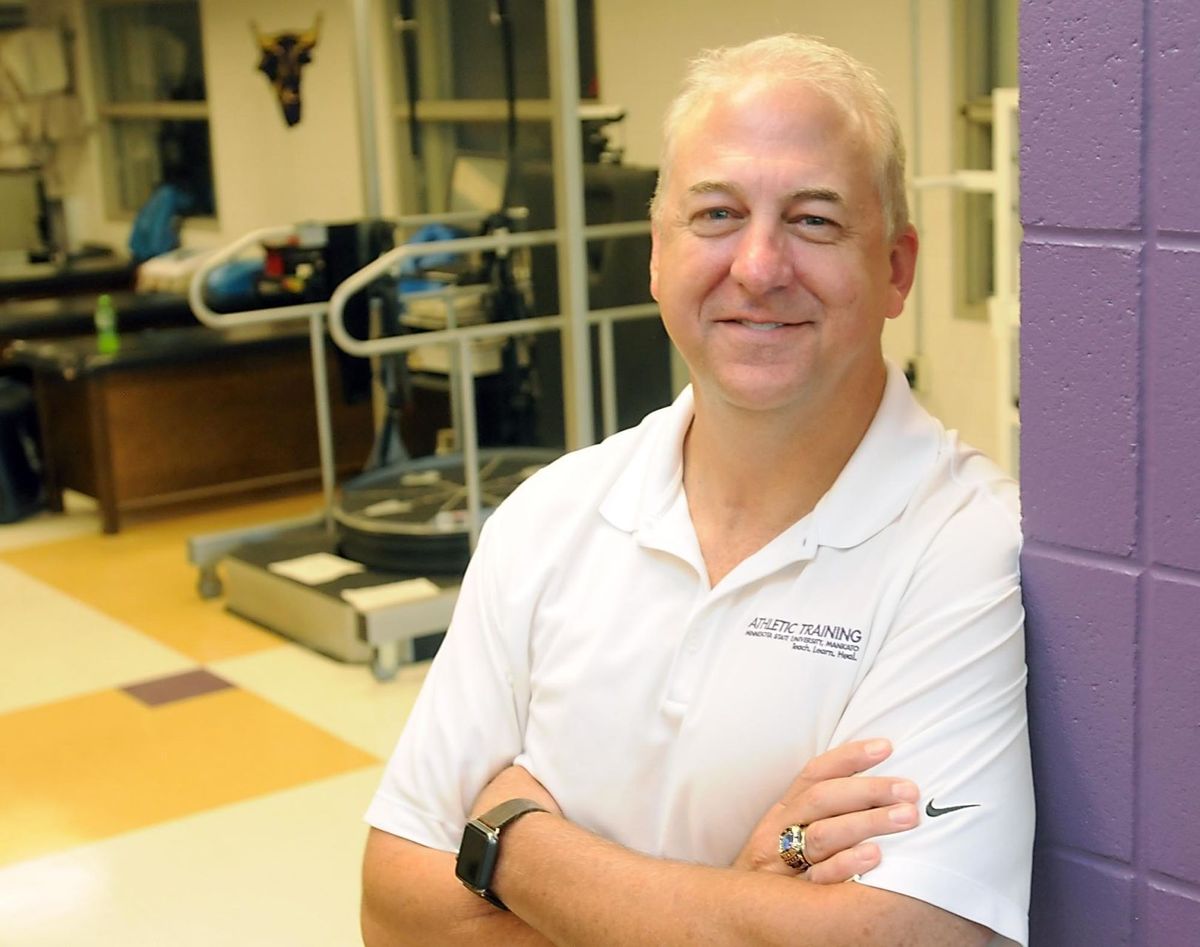
Article reposted from Mankato Free Press
Author: Jim Rueda
Over the years, Minnesota State’s Pat Sexton has garnered his share of awards. The professor and director of athletic training education at the college received a big one last month when he was inducted into the National Athletic Trainers’ Association Hall of Fame.
“It’s still a little surreal to me,” Sexton said in his office this week. “The truth is I don’t feel very comfortable getting awards. I have a job that I get paid to do and a lot of it just comes from my desire to help students and athletes. To get an award for doing those things just seems a little odd to me.”
Odd or not, Sexton is considered one of the pre-eminent educators and athletic trainers in his field. His journey began as an undergrad at Minnesota State in the early 1980’s, and he’s seen a lot of changes to his profession in the last 35 years.
The field of athletic training is constantly changing. “In fact,” said Sexton, “the only constant IS change.”
Concussions are the trendy topic in medical circles these days. Sexton said doctors and athletic trainers have come a long way from where they were two to three decades ago.
“It used to be if a player got his ‘bell rung’ but was still conscious and said he was all right to keep playing, the coach would just keep him in the game. We’ve learned how dangerous that can be.”
The cumulative effects of concussions may have long-lasting ramifications, and that’s why medical staffs are paying a lot more attention now. Not only do all the concussion symptoms have to abate before a player can return to the field, there is a progressive regimen of exercise that has to take place before he or she is cleared.
“But I’m sure that will change. too,” Sexton said. “Twenty years from now, they’ll probably look back and say ‘Really? That’s the way you treated concussions back then?’ ”
Sexton predicted the next two areas to garner attention will be heat-related illnesses and something called rhabdomyolysis (rhabdo for short).
Minnesota State may be a bit ahead of the curve when it comes to heat-related illnesses due to the death of Minnesota Viking offensive lineman Korey Stringer during training camp 15 years ago. The college and NFL have significantly stepped up awareness of the ailment since that tragedy.
Sexton said one of the main causes of heat-related illnesses is a lack of climatization.
“People sit in their air-conditioned offices or schools or houses or cars and then decide to go outside and work out for two or three hours,” he said. “That’s not good. The body needs time to adapt.”
Rhabdo is a condition in which damaged skeletal muscle breaks down rapidly. The condition can sometimes cause organ failure.
There was a case in Iowa not long ago when 16 members of a football team came down with it all at once. It tends to show up more frequently with crossfit workouts where there’s a lot of repetition. The muscles just break down.
Whatever the next injury-of-the-month turns out to be, Sexton is doing all he can to prepare himself and staff for its arrival. That means a lot of reading, a lot of research on the internet and attending a lot of clinics and conferences.
“New treatments are being developed all the time,” he said. “You have to sift through the ones that don’t pan out and try to determine the legitimate ones that actually work.”
Jim Rueda is the Free Press sports editor. Follow him on twitter @JimRueda
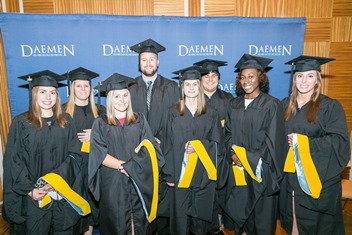
Article reposted from
Author:
For the fourth consecutive year, Daemen College’s athletic training graduates have earned a 100 percent first-time pass rate on the National Athletic Trainers’ Association (NATA) Board of Certification exam, far exceeding the national average of 83 percent.
“We are very proud of the success of our newest athletic training graduates on this rigorous national exam,” said Dr. Michael Brogan, vice president for academic affairs and dean of the college. “The consistently high success rate achieved on the exam is a true reflection of the strength of our program’s robust curriculum, the caliber of our students, and the effectiveness of our exceptional faculty in preparing our students at the highest professional level.”
Daemen’s 2016 athletic training graduates who attained a 100 percent first-time pass rate on the NATA Board of Certification exam are Paulina Behrens of Massena; Kolleen Brown of Willet; Joelle Davis of Buffalo; Rachel Reichart of Marilla; Meghan Short of Sandown, N.H.; Mitch Taffe of Ortonville, Minn.; Stephanie Woleben of Brocton; and Luis Zuniga of Rochester.
The exam tests knowledge, skills and abilities essential to the performance of athletic trainers. Once certified, athletic trainers, who specialize in the prevention, evaluation and rehabilitation of orthopedic injuries and conditions, must meet ongoing continuing education to remain certified.
Dr. Nicole Chimera, athletic training program director and associate professor, said the “impressive pass rates achieved on the certification exam over the past four years are a credit to the high standards we have set in the program. Clinical experiences offered in a range of professional settings coupled with a research component bolster the training and education students need to become skilled, qualified athletic training professionals.”
Daemen’s athletic training program, which was established in 2008, is one of only two in New York State and among 65 in the U.S. offered at the master’s level. Accredited by the Commission on Accreditation of Athletic Training (CAATE), the program has state-of-the-art educational facilities in the college’s new Academic and Wellness Center.
According to the U.S. Department of Labor’s Bureau of Labor Statistics, employment of athletic trainers is expected to grow 21 percent from 2014-2024, a rate much faster than the average for all occupations.
Additional information about Daemen’s athletic training program is available by calling 839-8413 or email nchimera@daemen.edu.